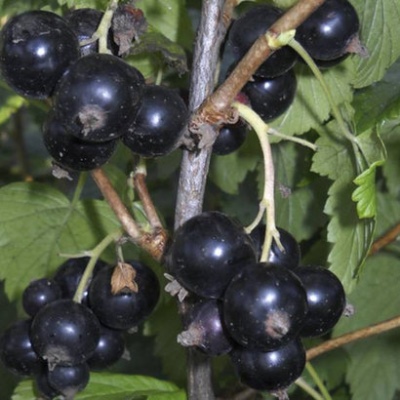
- Authors: V. S. Ilyin, N. A. Ilyina (South Ural Research Institute of Horticulture and Potato Growing)
- Appeared when crossing: Dove Seedling x Bradthorpe
- Year of approval: 2004
- Ripening terms: medium early ripening
- Growth type: medium-sized
- Yield: high
- Appointment: universal
- Berry weight, g: 2,3-7,5
- Tasting assessment: 5
- Escapes: medium, light pink, curved, hairless
Mermaid is a black currant variety bred by Russian breeders and approved for use in 2004. The variety was obtained by crossing the varieties of Dove Seedling and Bradthorpe.
Description of the variety
The presented variety is characterized by the following external features:
the bush is medium-sized, medium-dense, medium-spreading, reaches a height of 130-170 cm;
shoots of medium thickness, light pink color, no pubescence, curved shape;
leaves are large, carved, dark green, glossy, wrinkled;
flowers are medium, goblet, light pink;
brush length 5.5-6.5 cm, there are double specimens, medium density;
the axis is green, lint-free, has a long and thin petiole.
Characteristics of berries
The berries are almost black in color, the size is considered very large, the weight reaches 7.5 g, the shape is round.
Taste qualities
Despite the density of the skin, it is rather thin, therefore, when consumed fresh, it is almost not felt. In general, the fruits can be used as you like - both for making compotes and preserves, and for fresh consumption. The berries are sweet to taste, with a slight sourness, perfect for making healthy summer desserts, for example, a refreshing smoothie. The pulp is juicy, the taste is estimated at 5 points.
Ripening and fruiting
The presented variety belongs to varieties with a medium early ripening period. The crop can be harvested in the second decade of July, the berries ripen at the same time.

Yield
This is a high-yielding variety, which on average gives 6.0 t / ha or 46 kg / ha of berries, and the maximum you can get is 12.0 t / ha or 1.5-3.0 kg / bush.
Self-fertility and the need for pollinators
It is a self-fertile variety that does not need pollinator bushes around it.
Landing
Planting is recommended in autumn, in the second half of October. This is a light-loving crop that is best planted in a well-lit area. Use a few tips when landing:
when choosing a seedling, give preference to a two-year-old specimen with three or more skeletal roots;
choose a site with fertile, well-drained, light soil with a neutral or slightly acidic pH (5.5-6.5);
if the planting will be located along the fence, then place the bushes at a distance of 1.5 m from the object, observe a gap of 1.5-2 m between young shoots;
prepare the planting pits in advance, a couple of weeks before planting, fill them with humus, superphosphate and gray potassium in equal proportions;
after planting, cut the bush 10-15 cm from the ground so that the shoot takes root better.

Growing and care
Pay attention to the following points with further care.
Watering
The variety tolerates drought well. In a normal summer, it is enough to water the bush 1-2 times a month, in case of severe drought - once a week. The plant especially needs watering at the stage of ovary formation and flowering. It is best to moisturize in the morning. Use 40-50 liters of water at a time. After watering, it is advisable to loosen the soil between the bushes.
Trimming and shaping
Proper tree pruning contributes to high yields. Remove old and dried branches before frost and after winter. To stimulate the growth of a young plant, pinch the outermost buds for the growth of lateral shoots. Keep a maximum of two dozen young branches on the shrub - then you can expect a good harvest.
Top dressing
Fertilizers are introduced at the planting stage, additional feeding will not be required this season, they begin to be used from the second year. In spring, after the first buds bloom, urea or ammonium nitrate is suitable as an additive. In autumn, a mixture of compost (4-5 kg), potassium sulfate (1 s. L.) And superphosphate (2 tbsp. L.) Will be appropriate.




Disease and pest resistance
The variety boasts good immunity against fungal diseases, but powdery mildew or anthracnose can be affected. And also the plant has an average resistance to septoria and kidney mites.
A preventive measure can be regular inspection of the bushes for damage. Eliminate the affected leaves and branches, and then water the culture abundantly. Bordeaux liquid is considered a quality drug for the fight against parasites.

Currant is one of the most favorite crops of gardeners, it can be found on almost any personal plot. In order for the currant berries to be tasty and large, and the bush itself to be healthy and strong, you should properly care for, treat and protect the plant from harmful insects. It is important to recognize the signs of the disease in a timely manner and begin treatment in the early stages of plant damage.










































































